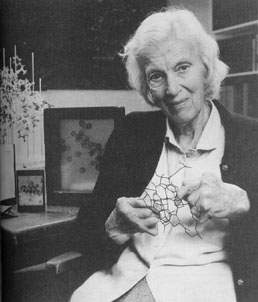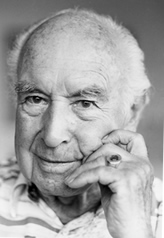Biography
| Dorothy Crowfoot Hodgkin | Albert Hofmann |
Scientific biographers do not, in general, find much correlation between good character and great science. There are a few exceptions. Historians have unanimously agreed, for example, that Charles Darwin was a particularly admirable, even lovable, figure: a collegial scientist, devoted father, faithful supporter of young colleagues, sincere, honest, and without personal enemies. The Darwin of our age is certainly Dorothy Crowfoot Hodgkin. In the words of colleague Max Perutz (Nobelist for his solution of the hemoglobin molecule), she was “a great chemist, a saintly, gentle and tolerant lover of people, and a devoted protagonist of peace.” In a short space it is impossible to discuss both the significance of her science and the scope of her tireless activity for world peace. Concentrating first on her contributions to science, she is known as a founder of the science of protein crystallography. She and her mentor, J.D. Bernal, were the first to successfully apply X-ray diffraction to crystals of biological substances, beginning with pepsin in 1934. Hodgkin’s contributions to crystallography included solutions of the structures of cholesterol, lactoglobulin, ferritin, tobacco mosaic virus, penicillin, vitamin B-12, and insulin (a solution on which she worked for 34 years), as well as the development of methods for indexing and processing X-ray intensities. After the work with Bernal, she established her own laboratory at Oxford, described in the memoirs of her many students as an unfailingly joyful and productive environment.* The challenges were always huge, as every new technique seemed to reach limits that constrained the size of protein that could be successfully solved, and each protein tackled presented special problems of its own. Hodgkin was elected a Fellow of the Royal Society in 1947 after publishing the structure of penicillin and was awarded the Nobel Prize in Chemistry in 1964 for her solution of vitamin B-12. The solution of the insulin structure came in 1969, after many years of struggle. Hodgkin and her collaborators produced a more refined solution in 1988, one that took full advantage of computational techniques that can now reduce the time for protein solutions from years to months or weeks. Hodgkin was the first of four daughters of John and Grace Crowfoot. Her father was an archaeologist working for the Ministry of Education in Cairo and her mother, an accomplished artist, was an expert on Coptic textiles. Dorothy married Thomas Hodgkin, an expert in African Studies, in 1937, and they had three children. Hodgkin’s role in the arena of science policy and international relations was a constant complement to her own scientific work. The entire family distinguished itself over more than three decades by working in the public arena for the cause of world peace. She belonged to many international peace organizations and, owing to Cold War restrictions, was not permitted to obtain a U.S. visa until 1990. Although she was over 80 and extremely crippled by rheumatoid arthritis, she lost no time in making a grand tour of U.S. institutions to discuss insulin, the history of crystallography, and its future. Her talks drew standing-room-only crowds at every stop. She suffered a stroke and died in 1994. * Guy Dodson, Jenny P. Glusker, and David Sayre (Eds.), 1981: Structural studies on molecules of biological interest: A volume in honor of Professor Dorothy Hodgkin. |
Albert Hofmann was born in Baden, Switzerland in 1906. In 1925 he began his studies in Chemistry in the Institute of Organic Chemistry at the University of Zürich. In 1929 he finished his doctoral work on the enzymatic degradation of chitin and chitosan in the laboratory of Paul Karrer. From 1929 to 1971, he dedicated himself to the study of the chemistry of natural products. During this period he worked in the pharmaceutical laboratories of Sandoz AG in Basel (now Novartis). His research was directed towards identification and synthesis of biologically active natural compounds from Scilla maritima of the family Liliaceae, from several species of Rauwolfia of the family Apocynaceae (also called the dogbane family) as well as from the fungi Claviceps purpurea and Psilocybe mexicana. It was his work on ergot alkaloids isolated from Claviceps purpurea, a fungus that grows on cereals such as rye, which made him known wordwide. In 1938, he synthesized for the first time LSD-25, by working on the central common component of ergot alkaloids isolated from Claviceps purpurea, lysergic acid. Five years later, Dr Hofmann discovered the psychedelic effects of LSD after accidentally absorbing some through his fingertips. His book, “LSD, My Problem Child,” recounts much of the history that developed after this fateful event. He became director of the natural products department at Sandoz and went on studying hallucinogenic substances found in Mexican mushrooms and other plants used by the aboriginal people. This lead to the synthesis of psilocybin, the active agent in many “magic mushrooms”. Albert Hofmann became interested in the seeds of the Mexican magic morning glory species Rivea corymbosa, the seeds of which are called Ololiuhqui by the natives. He was very surprised to find the active compound of Ololiuhqui chemically very similar to LSD. In 1962, he and his wife Anita travelled to southern Mexico to search for the magic plant “ska Maria Pastora” (“leaves of Mary the Shepherdess”), later known as Salvia divinorum. He was able to obtain samples of this plant but never succeeded in identifying its active chemicals. Dr. Dr. h.c. mult. Albert Hofmann was Fellow of the World Academy of Sciences, Member of the International Society of Plant Research and the American Society of Pharmacognosy. He was the author of over 100 scientific articles and wrote (or co-authored) a number of books, including “LSD, My Problem Child” (mentioned above), which is partly an autobiography and describes his famous bicycle ride. From this research arose highly valued drugs like Methergin and Hydergin, which are still used clinically today.
|

